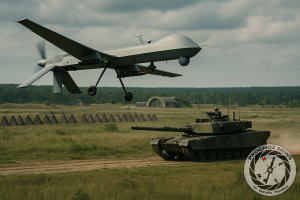A US Drone Wall in Europe?

By Matthew Parish, Associate Editor
The idea that the United States might trade forward-stationed, conventional forces in Europe for a network of combat drones has gained currency in debate: drones promise reach, lower manpower costs and rapid scalability. The war in Ukraine has accelerated interest in unmanned systems and revealed how cheaper, rapidly produced aerial and surface drones can generate disproportionate effects. But feasibility is not the same as attractiveness. A considered appraisal must weigh operational capability, deterrence psychology, logistics and basing, legal and political constraints, alliance politics, and the adversary’s counters. Drones may well be an indispensable complement and force multiplier for the eastern flank, but they cannot safely substitute for a credible, visible conventional presence. A hybrid posture that preserves distributed, survivable conventional forces while massively scaling unmanned effects is the more realistic and strategically sound path.
Operational capability and limitations
Unmanned systems have demonstrated remarkable utility at ranges and costs that alter tactical equations. The Ukraine conflict has produced numerous examples of tactical innovation — from loitering munitions to uncrewed surface vessels — and a lesson that distributed, networked unmanned systems can inflict outsized effects on higher-value targets. Western analysts emphasise that the United States and allies must learn from Ukraine’s acquisition and fielding of commercial technologies to accelerate their own unmanned capabilities.
Nevertheless there are clear technical and operational limits. High-end state-on-state combat against a peer adversary with sophisticated air defences, EW (electronic warfare), and cyber capabilities will place a premium on survivability, stealth, and secure command-and-control — attributes not yet ubiquitous amongst the cheaper drone types. Autonomous or semi-autonomous weapons present doctrinal and targeting challenges in a dynamic, congested battlespace; the International Institute for Strategic Studies and other analysts warn that many uncrewed systems were developed for lower-intensity employment and will struggle in a highly contested domain. In short, drones are superb at certain missions (reconnaissance, strike against exposed or lightly defended targets, counter-battery, persistent ISR) but are not a like-for-like replacement for the layered air superiority, integrated air defence suppression and armoured manoeuvre that conventional formations provide.
Deterrence, signalling and escalation psychology
Deterrence on NATO’s eastern flank is as much about perception and signalling as it is about pure capability. Host states and public opinion derive reassurance from visible boots, bases and armoured formations; forward-deployed troops demonstrate political commitment in a way that remote systems typically do not. Reducing conventional forces in favour of drones risks hollowing out the credibility that underwrites Article 5 assurances, especially amongst nervous frontline allies. Recent NATO moves to bolster the eastern flank — with deployments, exercises and explicit political commitments — underscore that message-value of presence remains central.
A drone-first posture also complicates crisis stability. Unmanned strikes and the rapid, sometimes opaque, attribution problems they create could lower the threshold for miscalculation. If a drone strike kills civilians or damages sovereignty, political leaders may feel compelled to respond forcefully, and the ambiguity around origin and intent of unmanned attacks can accelerate escalation. For deterrence to hold, any drone architecture must be embedded in clear political-military signalling and robust attribution mechanisms — something that would be more difficult, not easier, absent a visible conventional tail.
Logistics, basing and resilience
Drones are often presented as logistically light. In fact advanced combat and endurance systems require high-grade forward infrastructure: hardened launch and recovery sites, maintenance facilities, secure datalinks and redundancy in satellite and terrestrial communications. If the United States were to withdraw conventional units and rely on drone hubs, it would need host-nation access, hardened shelters, redundant C2 nodes and assured logistics lines. Those requirements may be more politically palatable in some NATO states than full bases — but they are not negligible. Moreover adversaries will target those nodes: a concentration of remote weapons tied to a small number of critical facilities is a tempting set of targets for long-range fires and cyber/EW attack. Recent articles on allied efforts to integrate counter-drone and defence systems on the eastern flank reflect an emphasis on distributed resilience rather than single points of concentration.
Alliances, burden-sharing and politics
A US decision to “rotate out” conventional assets in Europe would not be a purely military choice; it is a political one with wide ripple effects. Frontline states have consistently called for increased conventional capability and persistent presence. Polling and political debate in NATO capitals show sustained public support for troops on allied soil; senior officials have publicly urged increases in armour, artillery and air defences to deter a resurgent Russia. With domestic politics in the United States often fluctuating, a wholesale drawdown could be read by allies as an abandonment of guarantees and would likely prompt either a costly rearmament by Europe or the erosion of cohesion.
Adversary counters and an arms-race dynamic
An adversary determined to challenge NATO will adapt. Russia — which has invested in layered air defences, electronic warfare and standoff strike capabilities — will seek to degrade unmanned systems’ advantages through jamming, cyber-attacks, long-range fires and precision strikes against drone infrastructure. An exclusively drone-based posture thus risks an arms race in counter-UAV and anti-satellite measures where the defender may be at a relative disadvantage if its drone networks are more vulnerable than dispersed, human-centred formations.
Cost and industrial base considerations
Drones can be cheaper in per-platform terms, and mass production of low-cost loitering munitions has proven economically disruptive. Yet sustained high-intensity operations require an industrial surge capacity, ammunition, secure supply chains and export controls reconciled with allied procurement. The United States must also consider the political economy of jobs and basing in partner states: bases and troop presences have local economic effects that are politically important. Investments in an industrial base for advanced unmanned systems will be necessary but do not obviate the need for conventional capabilities.
Policy prescription: complement, distribute, and harden
A pragmatic, feasible approach is not to choose between drones or conventional forces but to pursue an integrated posture that leverages the strengths of both. Key elements should include:
• Rapid scale-up of unmanned ISR and strike capabilities tailored to the European theatre, prioritising secure datalinks, EW resilience and allied interoperability.
• Retention of distributed, expeditionary conventional units — smaller, more survivable and dispersed — to provide sovereignty guarantees, deterrent signalling and the human decision-making that complex operations require.
• Hardening and dispersal of drone basing, redundant C2 (command and control) nodes, and robust counter-UAV and integrated air defences to protect the networks that underpin unmanned effects.
• Alliance burden-sharing and political consultation to align public messaging and ensure that a new posture strengthens, rather than undermines, NATO cohesion.
Conclusion
Combat drones will be central to future operations on NATO’s eastern flank. They offer reach, persistence and cost-efficiency that no strategist can ignore. But they cannot fully substitute for the political and operational effects of credible, forward conventional forces. The feasible and prudent path is a hybrid: a much greater emphasis on unmanned systems married to distributed, survivable conventional forces, integrated air defences, hardened logistics and clear allied political signalling. That posture preserves deterrence, complicates an adversary’s calculus, and exploits the advantages of unmanned technologies without surrendering the unique strengths of human-centred conventional deterrence.
10 Views



